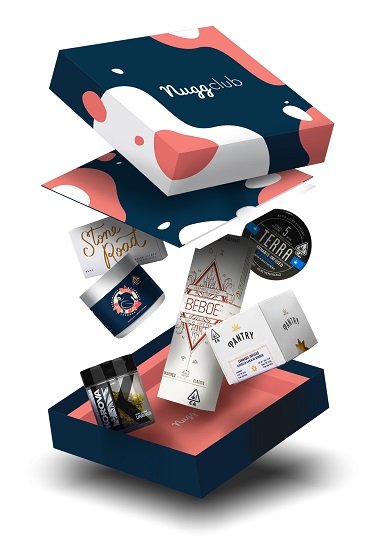The “green rush” is bringing hundreds, if not thousands, of brands and products to the cannabis market. As new products emerge, it’s becoming exceedingly difficult to make a new cannabis brand or product stand out. This is especially true in retail environments where the current dispensary experience doesn’t alleviate the uncertainty many consumers feel as they browse hundreds of different products, seemingly identical to one another and promising similar effects.
Subscription boxes solve marketing problems
Cannabis is a young industry; many customers visit dispensaries without knowing which product is best suited to their individual needs. Subscription boxes provide a unique solution for this daunting problem by
- giving brands control over their brand story,
- overcoming marketing obstacles,
- decreasing distribution costs,
- guaranteeing that products reach new customers,
- providing a more concrete and measurable return on investment (ROI),
- providing specific product feedback, and
- decreasing product launch expenses.
Building brand control
A brand’s largest distribution channel is the dispensary; it’s also one of the worst places for brand discovery. Brands lack control over how their products are displayed—often lost in a sea of selections—and are at the mercy of budtenders.
Patients and consumers usually turn to budtenders to shepherd them through the selection process. In fact, a recent Brightfield Group survey showed of the 500 cannabis consumers who responded, more than 90 percent rely on a budtender’s advice when considering what to purchase. This gives budtenders significant sway in the marketing process, which can be a big problem if they don’t know your product well. Akin to a game of telephone, the more intermediaries (i.e. budtenders) between a brand and the end consumer, the more diluted the message becomes.
Subscription boxes take the budtender out of this equation; meaning brands control the exact content of their messaging and can distinguish themselves from the sea of selections.
Overcoming marketing obstacles
Current marketing and advertising restrictions for cannabis products make it nearly impossible for brands to build equity and awareness in traditional ways. Commercial and print advertising in mainstream outlets are essentially a non-starter, and billboards and social media have strict regulations surrounding what can be stated and pictured.
Even if a billboard is approved, it’s hard to measure the ROI against the spend. MedMen’s splashy outdoor “Stoner” ads may have spurred important conversations around the stigma surrounding cannabis, but it’s hard to gauge the sales generated by that campaign.
Relying on online channels like review sites, display advertising through a limited selection of publisher sites, and buying listings on aggregator sites like Weedmaps and Leafly don’t fare much better. Even if a brand manages to find a customer online, they don’t have a direct way of delivering product to that customer. There needs to be a dispensary nearby.
With so many marketing restrictions it makes more sense for brands to directly target customers through a subscription model. This way, their targeting is further improved by providing a selection of products to customers based on their specific preferences.
Decreasing distribution costs
With traditional marketing methods, brands must rely on more costly means to connect with customers. In-store demos can give brands valuable face time with consumers, but their success depends on a variety of factors: the number of customers entering the store, the percentage of which partake in the presentation, and the effectiveness of the salesperson.
Companies must shoulder sales force and travel costs for demos as well, and they must maintain a budget large enough to support these activities. Small startup brands are immediately at a disadvantage in this industry because they can’t put out the same brute sales force that larger brands can.
The slotting fees for shelf space are an even larger burden, with no guarantee that a product will stand out from the fray. With a subscription box, however, brands can market directly to their customers in the most effective way, despite the regulatory barriers barring traditional outreach methods.
Guaranteeing product reach
Once a product reaches the dispensary shelf, is it guaranteed to reach the customer? This depends on a lot of factors, including the budtender’s personal preferences. Even if the product is prominently displayed with the most impressive packaging, it’s difficult to convince a consumer to try a new product at full price.
While a majority of consumers report wanting to regularly experiment with new products, few have the luxury of running such costly experiments. Trying a new product can cost $60 to $100 all-in with taxes, which encourages an anchoring bias towards the first brands a customer tries.
Subscription boxes arrive at the doors of customers seeking specific types of products bundled at a great value (50 percent to 60 percent off retail prices with some box offerings), which means both consumers and brands benefit from an increase in the number of products tried.
Unlike traditional marketing channels, brands can guarantee that nearly 100 percent of consumers who receive a box will try their product.
Providing measurable ROI and product feedback
Cannabis businesses, at least legal cannabis businesses, are running on razor sharp margins. Any guaranteed outreach efforts will help that margin significantly. Even better, the ROI can be measured with savvy subscription services that allow subsequent purchases of your product as add ons in future boxes.
Additionally, under a robust subscription model, recipients are able to leave reviews for products they received, which provides valuable information to brands on what consumers think of their products. It can also help brands understand how their products are being perceived and which demographics their products are most successful with, helping home in on future product development and marketing tactics.
Decreasing launch expenses

If a brand launches a new product through a subscription box, they can use these advantages to collect feedback quicker and cheaper than through retail, meaning less upfront investment and risk.
But the cost advantages to launching a new product don’t stop there. A typical launch for a brand involves educating budtenders, giving away free products to their top ten to fifteen dispensary partners, then throwing events at all these top shops. After that, if there’s traction and if there’s money left over, they go sell to other shops.
And that’s for the big brands that can afford this process. For brands big and small, launching a new product through a subscription box is both dramatically cheaper and more effective.
Final thoughts
Recently, other industries have used the popularity of subscription services and boxes to aid in brand discovery. How does a new mascara or rosé really break through the noise of other similar products on a densely stocked shelf? Subscription services like IPSY and Winc provide a tailored selection of products to their customers, putting preferred brands directly into the hands of the consumer. In addition, the category is growing. A study by Hitwise showed visits to subscription box websites have grown 3,000 percent over the last three years.
Subscribers also provide brands an additional marketing boost. Recipients often share photos of their boxes on social media. This avenue of marketing is substantial considering there are 1 billion people using Instagram every month and 500 million using Instagram Stories daily. What’s more, 62 percent of people said they have become more interested in a brand after seeing it on Instagram Stories. This provides a powerful platform to aid in brand discovery and raise awareness across the country.
What’s more, subscription boxes have the ability to offer products at a steep discount—sometimes up to half the cost—providing value to consumers who may not otherwise indulge in a specific product outside their price range. Once subscribers try these premium products, however, they realize the value the product offers and are more inclined to become a repeat purchaser.
Considering the hurdles new cannabis products face, it’s time for brands to join the subscription box movement. The model already has proven successful for brands in other spaces and is a low-risk, lower-cost strategy that solves the issue of brand awareness and product iteration via customer feedback.
 Alex Milligan is co-founder and chief marketing officer at Nugg, where he is responsible for overall marketing, branding, and growth strategy for the Nugg Market, NuggMD, and Nugg Club brands. He has a proven track record of unlocking sustainable growth channels with little budget, time, and human resources, allowing Nugg to remain bootstrapped since its inception in 2015. Prior to founding Nugg, Milligan was one of the leading independent affiliate marketers for Lyft, where he (along with his current co-founders) acquired over 40,000 new users for the company in under 11 months as a junior in college. Milligan earned a bachelor’s degree in Business Administration at the University of Southern California in 2015.
Alex Milligan is co-founder and chief marketing officer at Nugg, where he is responsible for overall marketing, branding, and growth strategy for the Nugg Market, NuggMD, and Nugg Club brands. He has a proven track record of unlocking sustainable growth channels with little budget, time, and human resources, allowing Nugg to remain bootstrapped since its inception in 2015. Prior to founding Nugg, Milligan was one of the leading independent affiliate marketers for Lyft, where he (along with his current co-founders) acquired over 40,000 new users for the company in under 11 months as a junior in college. Milligan earned a bachelor’s degree in Business Administration at the University of Southern California in 2015.













